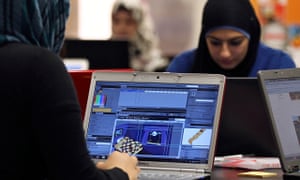Microfinance in Jordan isn’t helping to empower women
Foreign donors need to reconsider how their money is being used, as profits are taking precedence over sustainability
Supported by
Estee Ward
Wed 20 Aug 2014 10.47 BST
Women at their computers in Amman. Access to credit for businesswomen can be a mixed blessing. Photograph: Muhammad Hamed/Reuters
Jordan is trying to economically empower women by providing cash for micro to small enterprises. Depressingly few women work in formal jobs, but many [url=http://www.mop.gov.jo/uploads/informal sector panoramic study final.pdf]work informally[/url] (pdf), in areas such as tailoring,
ghee manufacturingand
leather craftwork. But does the country’s microenterprise development strategy, heralded by the government and foreign aid donors, hinder the women it is supposed to help?
The issue is not the amount of funding given, but the lack of clarity about how it is distributed. Since 2012 Jordan has been given more than $250m by aid agencies and
foreign governments (pdf) to expand its
enterprise development for inclusive growth programme. Much of this aid has gone towards increasing financial access, either as direct loans to local projects or as lines of credits (LOCs) for microfinance institutions (MFIs).
In the fertile governorate of Ajloun, I met around 20 women who had received loans for household ventures, such as yoghurt manufacturing and tailoring services. Almost all complained that the process lacked proper evaluation. Some women received half of what was requested for startup costs, while others were offered more than they could afford and failed to pay back the full amount.
The microfinance industry appears to be a burgeoning market with untapped potential: it has the third-largest gross loan portfolio – the total amount of money lent across all MFIs – in the region, reaching
18% of potential demand, with women
making up 71% of clients. But these numbers are misleading.
First, donors have been assessing the industry through the lens of MFI profit margins, not social impact –
though they claim to meet social ends by aiding job creation and business expansion. This encourages microfinance lenders with access to credit to invest in building their own businesses. Strengthening financial literacy and legal skills to help clients use their loans productively and become better business women is less of a priority.
Though annual figures aren’t published, some NGOs say microfinance’s return on equity in Jordan is well above the global average of 10%, with the largest MFIs reaching as high as 20-30%.
Loan guarantees ensure a big portion of that return, which is problematic if we’re talking about true sustainability. And high profits inevitably mean high interest rates. Among a focus group of 15 women who borrowed money to start a business, high interest rates forced more than half to use savings for payments and spend the initial loan on immediate needs, such as utilities and healthcare, rather than on what it was intended for. Many women experienced shame for their apparent failure, and deferred loan management to their husbands.
Compounding the problem is a lack of regulation. No laws for microfinance exist in Jordan. Almost all MFIs are registered as non-profit companies or NGOs – as social entities, they are not obliged to pay taxes, or to cap interest rates. It is also unclear which government department has oversight of these firms. It straddles the ministries of social development and trade, although academics from the University of
Jordan rate the ability of both ministries to evaluate microlender operations as questionable at best. Regulatory processes are thus susceptible to negligence and corruption.
There is a proposal under parliamentary committee review to place MFIs under the jurisdiction of Jordan’s central bank as fully fledged financial institutions, with the hope that their new status will decrease corruption and ensure prudent regulation. But placing MFIs in the banking system could push them further away from the social responsibilities they should uphold. Increased regulation may add to government coffers, but it won’t benefit clients who need more than a loan to be economically successful.
Women, especially those who are less educated, should have access to a range of services: accounting courses, business mentoring, local partnerships, advice on signing contracts. Surveys, [url=http://www.mop.gov.jo/uploads/Gender and Microfinance Sector 2012.pdf]including those done by the World Bank and Jordan’s planning ministry[/url] (pdf), show that without such support women are prone to accept contracts without knowing their full rights or obligations.
Outside the MFI industry, local women are providing these services at the grassroots level, and women can access finance from large family or tribal associations involved in informal lending to community networks.
But these community leaders and loan beneficiaries have been left out of discussions. If the ultimate goal of microfinance is to empower poorer people, particularly women, it is disappointing that underlying strategies are conceived and executed by those at the top.
Implementing a financial regulatory framework via Jordan’s central bank is a good first step. But donors funding microfinance need to take a step back and reconsider how their money is being used and who calls the shots.
Profits shouldn’t take precedence over sustainability, which is determined not by the amount of credit available to a woman, but by the resources she can leverage to improve her life. Until then, microenterprise development for women in Jordan is failing on its own terms.
